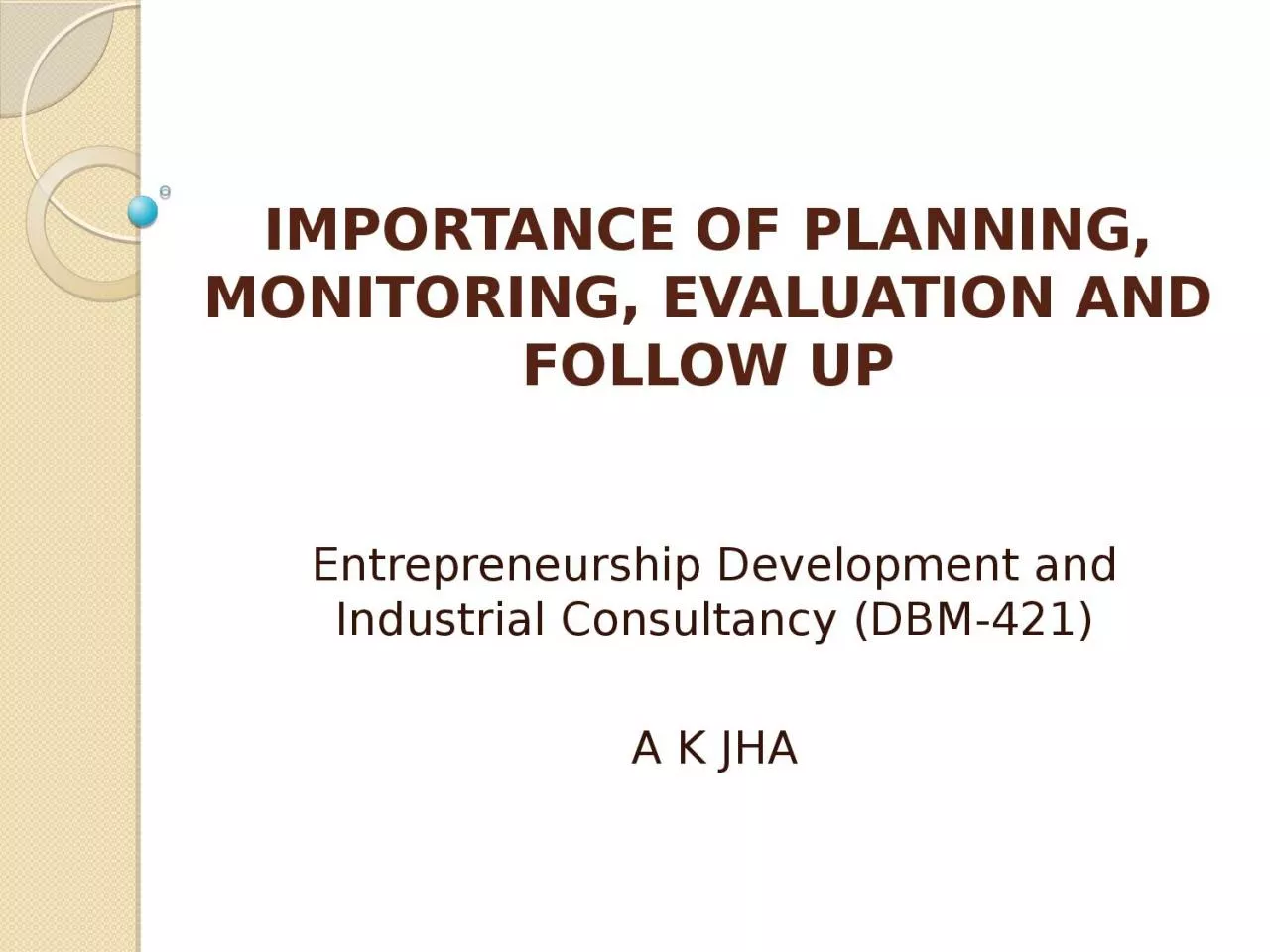

Entrepreneurship Development and Industrial Consultancy DBM421 A K JHA Introduction Planning monitoring and evaluation PME and follow up are the key managerial functions Once the plan is prepared and implemented its monitoring and evaluation are essential to see whether the plan is proc ID: 1003191
Download Presentation The PPT/PDF document "IMPORTANCE OF PLANNING, MONITORING, EVAL..." is the property of its rightful owner. Permission is granted to download and print the materials on this web site for personal, non-commercial use only, and to display it on your personal computer provided you do not modify the materials and that you retain all copyright notices contained in the materials. By downloading content from our website, you accept the terms of this agreement.
1. IMPORTANCE OF PLANNING, MONITORING, EVALUATION AND FOLLOW UPEntrepreneurship Development and Industrial Consultancy (DBM-421)A K JHA
2. IntroductionPlanning, monitoring and evaluation (PME), and follow up are the key managerial functions. Once the plan is prepared and implemented, its monitoring and evaluation are essential to see whether the plan is proceeding as per the original plan or there is any deviation. If deviations are found mid-course correction measures are essential to get the desired impact. In case of enterprise, planning is related to business plan activities.
3. Business PlanA business plan acts as a guide for entrepreneurs. It serves the following main functions:It provides logical and structural overview of the enterprise highlighting the key activities to be carried out in different phases.It provides guidelines to compare ongoing progress.It identifies the key resources (man power, machines, time etc.) required at different stages of growth of enterprise.It helps in participative management as all the employees are aware about future activities.It provides an authentic document for communicating aspects of enterprise with financers, government and other stakeholders.
4. Steps in Business Planning ProcessIdea generation: This is the first preliminary stage of business planning process. Assessing the environment: It is necessary to analyze both macro (external) and micro (internal) environments to know strength, weakness, opportunities and threats faced by the organization/entrepreneur. Feasibility analysis: On finding the environment suitable for the enterprise, detailed feasibility study is to be carried out viz., market feasibility, technical/ operational feasibility and financial feasibility.Project report preparation: Using the information so far collected, a project report/ business plan is prepared. A business plan is a written document describing step by step strategies to establish and operate an enterprise.Evaluation, control & review: In order to retain leading position in today’s competitive business world, it is necessary for an enterprise to continuously evaluate the functioning and do necessary revisions in the light of changed circumstances.
5. Developing a Business PlanA business plan is an important step in establishing any new enterprise. It acts as a roadmap to guide the future of the enterprise and provide direction for expansion, diversification and evaluation of the enterprise.Format of Business PlanThe business plan should be professional so that enterprise is portrayed in a positive manner. Financial assistance is obtained based upon business plan. A business plan should include executive summary, mission statement, goods and objectives, back ground information, organizational matters, marketing plan and financial plan.Executive SummaryIt describes the business or proposed changes to the existing business and category of industry to which the business / enterprise belongs. It outlines the direction and future plans or goods of the company, the methods to be employed to achieve the goals. It also describes challenges that will be faced by the enterprise / business.
6. Mission, goals and objectivesThe mission statement should be shortshould give the key idea or reasons for existence of enterprise. Goals and objective should showwhat the business wishes to accomplish and the steps needed to obtain the desired results. Goals and objectives should be specific, measurable, attainable, reasonable and time bound. Background informationThis covers information about history of the enterprise, the current state of industry in which enterprise fall and information from the reputed sources about future of industry in which enterprise falls
7. Organizational structureThis includes description about organizational structure, management team, risk management etc. There are different forms of organization structures. The structure selected should be appropriate to the management skills and style of the owners.Marketing planIt covers aspects like characteristics and advantages of product of the enterprise, sales location, promotion, advertising, pricing and the associated costs of all market related activities.Financial planThis covers aspects of types of records to be maintained, signing authority for banking transactions, financial assumption etc. Financial projection for at least five years should be indicated.